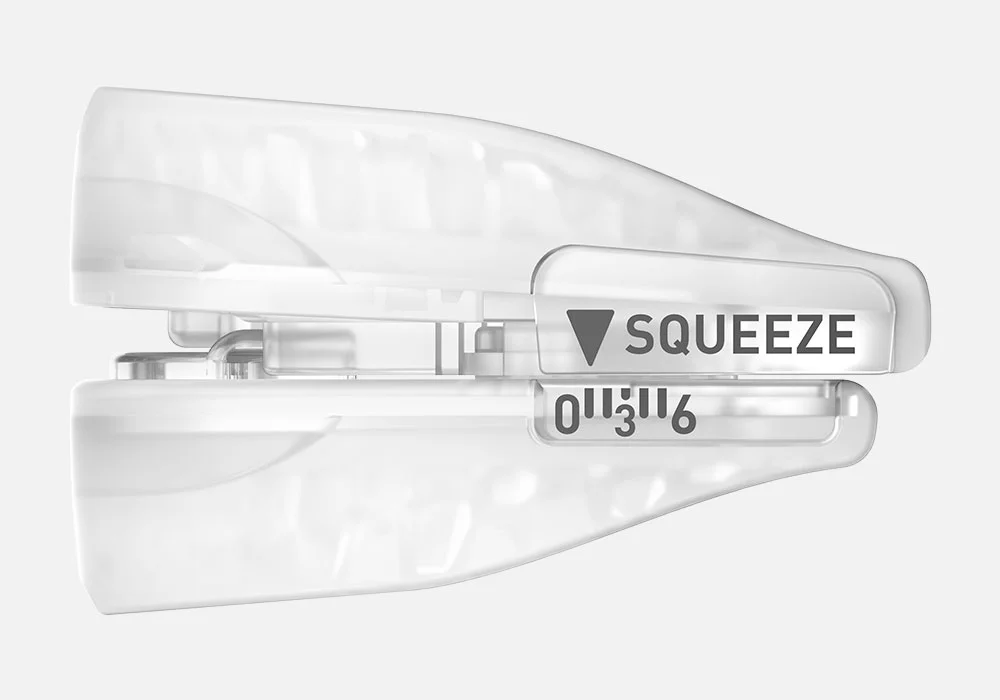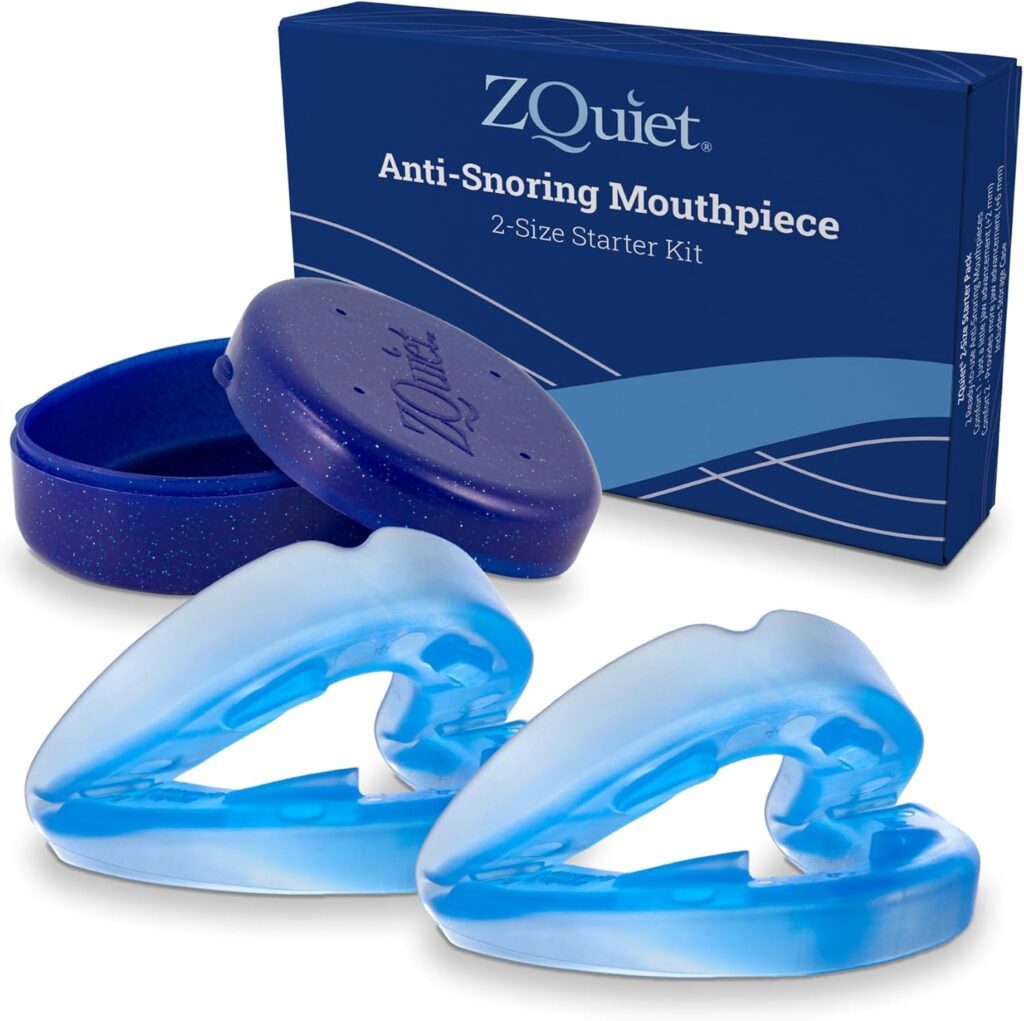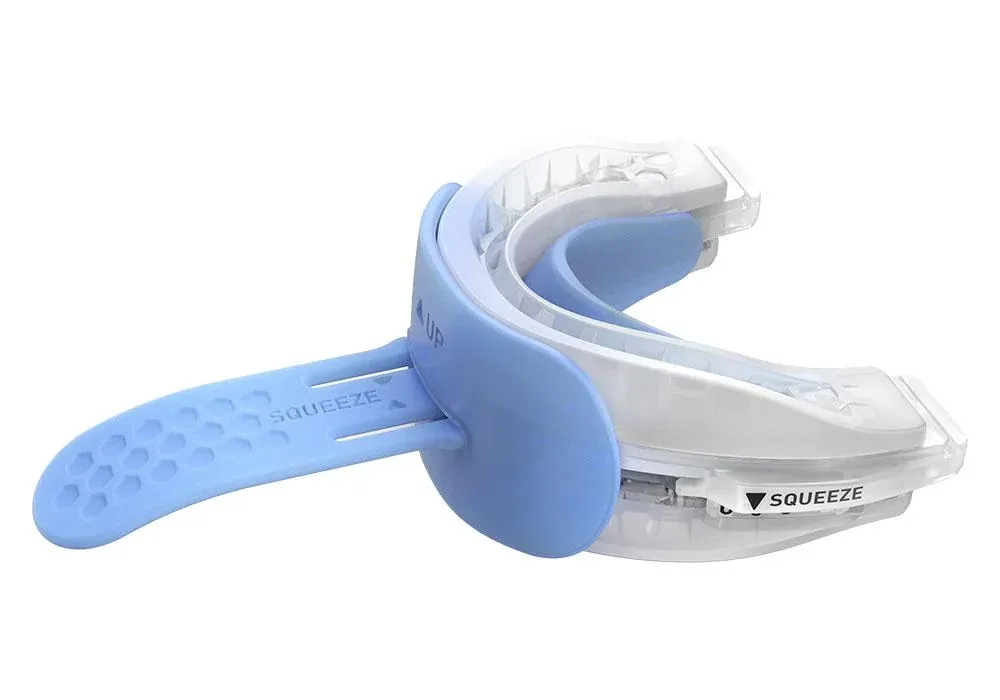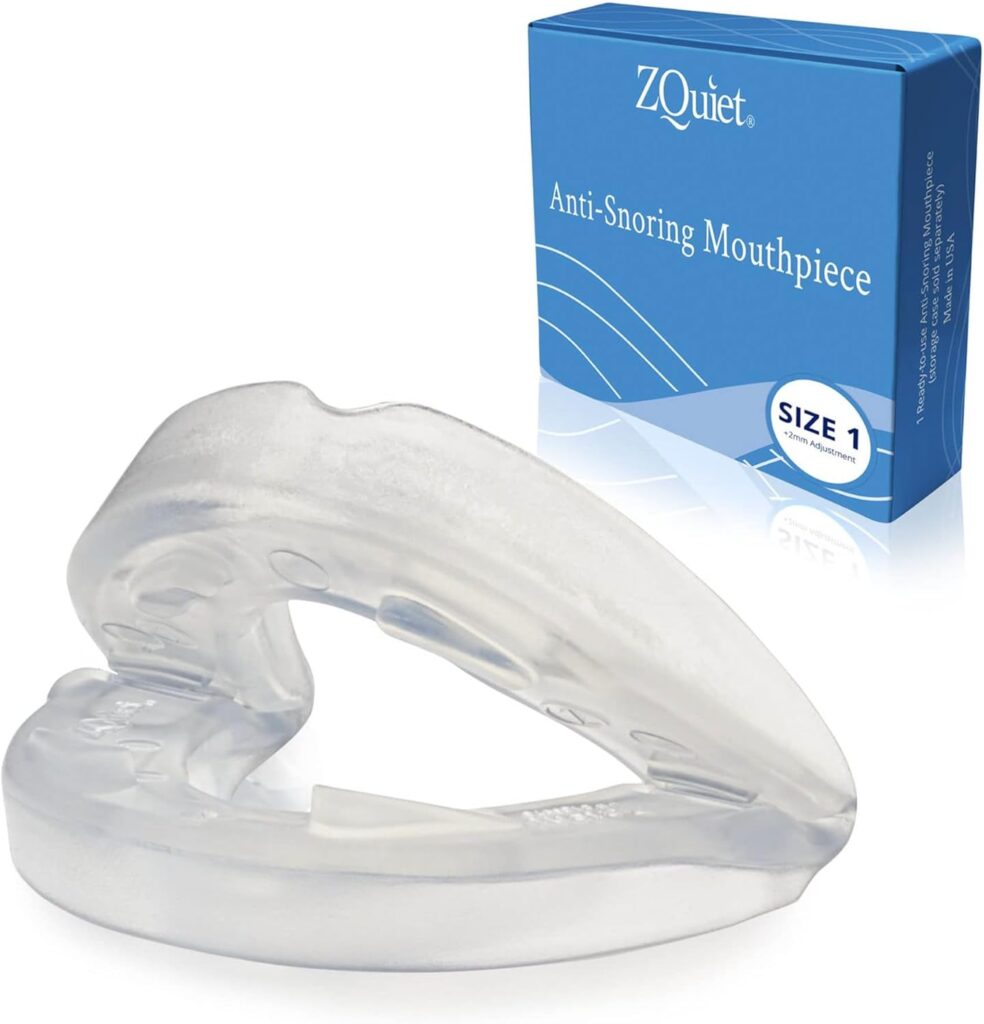SnoreRx vs ZQuiet: Which Anti-Snoring Mouthpiece Works Best?
Snoring disrupts more than just your sleep—it affects your relationship and overall health.
If you’re comparing SnoreRx vs ZQuiet mandibular advancement devices, you’re already taking a smart step toward quieter nights. Both are popular FDA-cleared anti-snoring mouthpieces, but they take different approaches to jaw advancement.
I’ve done the research and testing to break down the pros and cons of SnoreRx and ZQuiet, so you can decide which might work best for your situation.
Jump to: Quick Comparison Chart | How MADs Reduce Snoring | SnoreRX Overview | ZQuiet Overview | Airflow & Breathing | Comfort & Adaptation | Effectiveness in Snoring Reduction | Durability and Cleaning | Pricing, Trials & Guarantees | Travel & Daily Use | Dental Work | Safety & FDA Status | Side Effects & Adjustment Period | Conclusion
SnoreRx vs ZQuiet: Quick Comparison Chart
| Feature | SnoreRX | ZQuiet |
|---|---|---|
| Setup | Boil-and-bite custom fit | Ready to use immediately |
| Adjustment | 1 mm increments (up to 6 mm) | Two preset positions |
| Airflow | Front breathing vents allow mouth breathing | Open design supports natural airflow |
| Comfort | Custom-molded and secure. If you want a slimmer profile, choose SnoreRx Plus. | Lighter, flexible feel out of the box |
| Lifespan | ~9–11 months | ~12+ months |
| Cleaning | More detailed clean due to crevices | Simpler, open surfaces clean faster |
| Best for | Comfort, custom fit, and mouth-breathing friendly | Simple setup and travel friendly |
| Check SnoreRX Price | Check ZQuiet Price |
Disclosure: This article is reader supported and contains affiliate links. We earn on qualifying purchases at no extra cost to you.
How MADs Reduce Snoring
Before we get into the nitty-gritty details of each device, it’s helpful to understand how Mandibular advancement devices (MADs) work in general.
The basic principle is pretty simple, these mouthpieces gently push your lower jaw forward while you sleep. This slight advancement helps keep your airway more open, reducing the vibrations in your throat tissues that cause snoring.
It’s a straightforward concept, but the execution and design details can make a big difference in comfort and effectiveness. Let’s take a closer look at how SnoreRX and ZQuiet approach this anti-snoring solution.
Overview of SnoreRx

| Pros | Cons |
|---|---|
|
|
Fit & Setup
SnoreRx uses a boil-and-bite fitting process that creates a custom impression of your teeth. You heat the device in hot water, then bite into the softened material to create a personalized mold. This customization takes about 15 minutes initially but creates a secure fit tailored to your mouth’s unique shape.
Adjustment Range
The standout feature of SnoreRx is its Micro-Fit technology. You can fine-tune the jaw advancement in precise 1mm increments, up to a total of 6mm. This calibration system lets you find the exact position that reduces snoring without causing excessive jaw discomfort.
Mouth Breathing
SnoreRx features dedicated front air holes that accommodate mouth breathing. This V-Flow™ design is particularly beneficial for those with nasal congestion, allergies, or who simply prefer breathing through their mouth during sleep. The airflow remains adequate even with the mouthpiece in place.
SnoreRx’s latest model, the SnoreRx Plus, allows for better comfort with its vertical movement design and hinged flexibility for natural jaw movement during sleep.
Overview of ZQuiet

| Pros | Cons |
|---|---|
|
|
Two Sizes/Advancement
ZQuiet comes ready to use with two different advancement settings. The device includes two separate mouthpieces (A and B) that provide different levels of jaw positioning. This simplified approach eliminates complex adjustments while still offering some customization flexibility.
Flex & Comfort
The thin, flexible thermoplastic material distinguishes ZQuiet from more rigid competitors. Its living hinge design allows for natural mouth movement, including slight opening and closing during sleep. Many users find this flexibility creates a less restrictive, more comfortable experience.
Dry-Mouth Notes
ZQuiet’s more open design can sometimes lead to dry mouth, especially when first adapting to the device. The airflow is excellent, but the slightly open mouth position may cause some initial dryness. Staying well-hydrated before bed and using a humidifier can help mitigate this issue.
SnoreRx vs ZQuiet: Airflow & Breathing
Being able to breathe comfortably while wearing an anti-snoring device is crucial for actually using it consistently. Both SnoreRx and ZQuiet have taken steps to address this, but in different ways.
- SnoreRx features front air holes that allow for mouth breathing. This can be really important for people who have nasal congestion or just prefer to breathe through their mouths at night. The holes are designed to provide enough airflow without compromising the snoring reduction benefits.
- ZQuiet’s more open design naturally allows for easier breathing. The flexible material and lack of full coverage mean your mouth isn’t as restricted. However, some users report that this openness can lead to dry mouth issues, especially if you’re not used to sleeping with your mouth slightly open.
Your typical breathing patterns should factor into your decision between these two devices. If you’re a habitual mouth breather or often deal with congestion, SnoreRx’s air holes might be the better choice.
If you prefer a less restrictive feeling and don’t mind the potential for some dry mouth, ZQuiet could be more comfortable over the original SnoreRx.
SnoreRx vs ZQuiet: Comfort & Adaptation
SnoreRx users often report that the ability to make micro-adjustments helps them find a comfortable position more easily. You can start with a minimal advancement and gradually increase it as you get used to the device.
The custom-molded fit also tends to feel more secure and less intrusive for many users.
ZQuiet’s flexible material and simpler design can feel less bulky in your mouth. Some users find this more comfortable right from the start, especially if they’ve struggled with larger MADs in the past.
The trade-off is less customization if you need a very specific jaw position to stop your snoring.
Both devices require an adaptation period as your mouth adjusts to sleeping with a foreign object. Initial jaw soreness, excessive salivation, and mild discomfort are common in the first few nights with any MAD.
This is normal and usually subsides within a week or two as your mouth gets accustomed. If discomfort continues or worsens, it’s important to stop using the device and ask your doctor or dentist.
SnoreRx vs ZQuiet: Effectiveness in Snoring Reduction
The big question is, of course, how well do these devices actually work to stop snoring? Effectiveness can vary widely from person to person.
Factors like the cause and severity of your snoring, jaw structure, and even sleeping position can all impact how well a MAD works for you.
SnoreRx’s customization options give it an edge for many users in terms of effectiveness. The ability to fine-tune the jaw position means you’re more likely to find the “sweet spot” that reduces or eliminates your snoring.
Users who have tried many MADs often report better results with SnoreRx because of this precision.
ZQuiet can be very effective for mild to moderate snorers, especially those who find a good fit with one of the two advancement options. Its simplicity means you’re more likely to use it consistently, which is key for any anti-snoring solution.
However, if you need a very specific jaw position to stop snoring, you might find ZQuiet’s limited adjustment options frustrating.
Both devices have plenty of positive user reviews and testimonials from satisfied customers who report significant reductions in snoring. It’s worth noting that neither device is likely to completely eliminate very severe snoring, especially if it’s caused by underlying health conditions like sleep apnea.
SnoreRx vs ZQuiet: Durability and Cleaning
Both devices require daily cleaning to maintain hygiene and extend lifespan. You’ll need to brush them with toothpaste or mild soap to remove bacteria and prevent odors.
SnoreRx typically lasts 9-11 months with proper maintenance and depending on usage. Factors such as teeth grinding can affect lifespan.
The SnoreRx Plus model features a detachable design that makes cleaning significantly easier—simply brush with toothpaste after every use and use a disinfectant spray for odor control. This improved design addresses the cleaning challenges of the original model.
ZQuiet generally lasts 12+ months with proper care. Its simpler, one-piece design makes cleaning straightforward—just brush with mild soap and rinse thoroughly.
Both require thorough drying before storage to prevent bacterial growth. Neither should be cleaned with harsh chemicals or extremely hot water, which can warp the materials.
SnoreRx vs ZQuiet: Pricing, Trials & Guarantees
Cost is always a consideration when choosing a sleep solution. SnoreRx typically comes with a higher upfront price tag, reflecting its more advanced customization features.
ZQuiet’s lower initial cost makes it an attractive option for those just starting out with anti-snoring devices or who are on a tighter budget.
Both companies offer money-back guarantees, which can provide some peace of mind when trying out a new solution. It’s worth checking the current pricing and any available promotions when making your decision, as these can change over time.
SnoreRx vs ZQuiet: Travel & Daily Use
The ZQuiet anti-snoring mouthpiece’s simpler design and ready-to-use nature make it more travel-friendly. The slim profile fits easily in its travel case without taking up much space in your toiletry bag. For frequent travelers, this convenience can be a deciding factor.
SnoreRx’s bulkier design and custom-fitted nature make it slightly less travel-friendly, though its secure fit means it’s less likely to fall out in unfamiliar sleeping environments. Both devices include carrying cases that protect them when not in use.
Establishing a simple routine—wearing the device, morning cleaning, and proper storage—helps ensure consistent use and maximum benefit from either option.
SnoreRx vs ZQuiet: Dental Work Compatibility
If you have dental work like bridges, crowns, or dentures, compatibility with anti-snoring devices becomes an important consideration. Both SnoreRx and ZQuiet can work with some types of dental work, but there are limitations.
SnoreRx’s boil-and-bite fitting process means it can often accommodate dental work more easily, as the impression will form around your existing teeth and restorations. However, it’s not recommended for use with full dentures or very loose teeth.
ZQuiet’s one-size-fits-most approach means it doesn’t conform as closely to your teeth. This can be a better option if you have extensive dental work, as there’s less risk of the device interfering with crowns or bridges.
However, it may not provide as secure a fit for some users.
In all cases, it’s best to ask with your dentist before using any MAD if you have significant dental work or concerns about compatibility.
Safety & FDA Status
Both SnoreRx and ZQuiet have received FDA clearance as Class II medical devices for the treatment of snoring. This means they’ve met certain safety and effectiveness standards set by the U.S. Food and Drug Administration.
Be aware that FDA clearance is not the same as FDA approval. Clearance means the devices are considered substantially equivalent to other legally marketed devices for the same use.
It doesn’t guarantee effectiveness for every user but does provide some assurance of basic safety standards.
Both devices are made from materials that are considered safe for oral use. Neither device contains any metal parts, which is important for people who have metal allergies or sensitivities.
Side Effects and Adjustment Period
It’s important to be aware that both devices can cause some side effects, especially when you first start using them. These are generally mild and temporary, but they can impact your willingness to stick with the treatment.
Common initial side effects for both SnoreRx and ZQuiet include:
- Excessive salivation or dry mouth
- Mild jaw soreness or tension
- Temporary changes in bite alignment upon waking
- Minor tooth discomfort
These usually resolve within 1-2 weeks as your mouth adapts. If symptoms persist or worsen, discontinue use and consult a healthcare provider.
Importantly, if you experience any of these warning signs, seek professional medical evaluation:
- Excessive daytime sleepiness despite reduced snoring
- Observed breathing pauses during sleep
- Morning headaches or continued fatigue
- Persistent loud snoring despite using the device correctly
These could indicate sleep apnea, which requires medical intervention beyond what anti-snoring mouthpieces can provide.
SnoreRx vs ZQuiet: Which Anti-Snoring Device is for You?
So, which anti-snoring device comes out on top? There’s no one-size-fits-all answer.
Both SnoreRx and ZQuiet have their strengths and potential drawbacks, and the best choice depends on your person needs and preferences.

SnoreRx is the clear winner if you:
- Want a micro-adjustable fit you can tune night by night
- Prefer a custom mold for a stable, comfortable feel
- Need a vented design to support mouth breathing
- Have tried other MADs without success

ZQuiet might be the better choice if you:
- Just want something simple and easy to use
- Have mild to moderate snoring
- Prefer a more flexible, less bulky mouthpiece
- Travel frequently
Both devices can meaningfully cut down snoring for many users. If you want a balance of slim feel and precise tuning, SnoreRx Plus is a strong “best of both worlds” pick: it keeps the boil-and-bite custom fit and 1 mm adjustments, in a lower-profile build with front vents for mouth breathing.
If you have a smaller jaw or simply prefer the least bulk, ZQuiet remains a practical option thanks to its slimmer, flexible design and two advancement levels.
Anti-snoring mouthpieces aren’t a cure-all. If your snoring is severe, you’re sleepy during the day, or you suspect sleep apnea, speak with a healthcare professional for screening and treatment advice.
Whichever device you choose, be patient with the adjustment period and give it a fair trial. Many users find that the initial discomfort is well worth the peaceful nights and energized mornings that follow.
Frequently Asked Questions
What is the difference between SnoreRx and ZQuiet?
SnoreRx offers more customization with micro-adjustments and a boil-and-bite fitting process, while ZQuiet provides a simpler, ready-to-use design with two preset advancement levels.
How long do SnoreRx and ZQuiet typically last?
SnoreRx usually lasts about 9-11 months with proper care, while ZQuiet can last a year or more.
Can I breathe through my mouth with these devices?
Yes, both devices allow for mouth breathing. SnoreRx has specific air holes for this purpose, while ZQuiet’s open design naturally allows for mouth breathing.
Are SnoreRx and ZQuiet effective for sleep apnea?
These devices are designed to treat snoring, not sleep apnea. If you suspect you have sleep apnea, it’s crucial to ask a doctor for proper diagnosis and treatment.
How do I clean SnoreRx and ZQuiet?
Both devices should be cleaned daily with a toothbrush and mild soap or denture cleaner. SnoreRx requires more thorough cleaning because of its design, while ZQuiet is generally easier to clean. SnoreRx Plus’ detachable design allows for less fiddly cleaning.
Can I use SnoreRx or ZQuiet if I have dentures?
Neither device is recommended for use with full dentures. SnoreRx may work with partial dentures in some cases, while ZQuiet’s design might be more accommodating for some types of dental work.
Do these devices cause jaw pain?
Some initial jaw soreness is common when starting to use any MAD. SnoreRx’s adjustability can help minimize this, while ZQuiet’s flexibility may cause less initial discomfort for some users.
How quickly do SnoreRx and ZQuiet work to reduce snoring?
Many users report a reduction in snoring from the first night of use. However, it may take a few nights to a week to find the right adjustment or get used to wearing the device.
Are SnoreRx and ZQuiet covered by insurance?
Coverage varies by insurance provider. Some plans may cover anti-snoring devices if prescribed by a doctor, but many consider them over-the-counter and do not provide coverage.
Can children use SnoreRx or ZQuiet?
These devices are generally not recommended for children or teenagers whose jaws are still developing. Always ask with a pediatrician or sleep specialist for childhood snoring issues.
Related Reading
- SnoreRx vs SnoreRx Plus
- PureSleep vs SnoreRx
- Best White Noise Machines for Snoring
- Best Anti-Snore Pillow for Side Sleepers
- Nitetronic Z6 Smart Anti Snore Pillow Review
- Snore Prevention Mouth Guard
- Best Nasal Dilators for Snoring
- Natural Remedies for Snoring
Medical Disclaimer: This article is for informational purposes only and does not constitute medical advice. Always consult with a healthcare professional before using any anti-snoring device, particularly if you suspect you might have sleep apnea or other sleep disorders.
